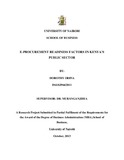| dc.description.abstract | This study has examined the e-procurement readiness in Kenya’s public sector, looking at how various factors impact on it. E-procurement in the public sector has been implemented, though not fully, with several modules being introduced to enable a full ERP system. Notable ERPs that are currently used by public institutions are the Integrated Financial Management Information System (IFMIS) and SAP software enabled them to procure online.The objective of the study was to determine the extent of e-procurement levels in public institutions in Kenya. With the objective of the study, relevant literature in relation to the objective was sought out. Similar studies in other countries were done and analyzed, with important aspects of readiness in these countries being noted. From these studies, important aspects were brought out and impacted the readiness of e-procurement readiness were procurement environment, legal environment, economic environment, organizational environment, and technological environment.The study compiled a questionnaire as a tool for primary data collection. Based on these readiness aspects the study sought to find whether the environmental aspects affected the readiness of e- procurement adoption in public institutions in Kenya. Data analysis was done using descriptive statistics and factor analysis. The sample of 50 units was selected from the various ministries and parastatals of which 46 responded and their responses analyzed.The study found that resistance to change, lack of enthusiasm, staff skills, and to some extent procurement policies impacted the readiness of e-procurement in public institutions. With factor analysis done on the responses, the KMO measure of sampling had a value of 0.565 which indicated that distinct factors can be formed. The extracted factors from the rotated component factor matrix were technology (factor
1), organization’s finance (factor 2), leadership and integrity (factor 3), legal framework and technical preparedness (factor 4), international law and employee attitude (factor 5), procurement policy and national procurement law (factor 6), e-procurement adoption and staff I.T adequacy (factor 7), and online marketplace and government support (factor 8).It was therefore seen technology and legal framework and procurement policies were factors that respondents agreed to affect the readiness of public procurement institutions in Kenya. Also, the extent of procurement level in public procurement was low as there was no integration with other systems and low use in electronic commerce. Challenges encountered in e-procurement readiness were staff skills, resistance to change, and lack of enthusiasm by staff. Recommendations made were for the government and e-procurement stakeholders to improve the legislative framework and procurement policies as these were found to impact the readiness of e-procurement adoption in Kenya.The study concluded by suggesting that more needed to be done on the factors affecting e-procurement readiness in Kenya, and other factors that may affect preparedness of its adoption can also be analyzed in further studies. Also the study may be carried out in the private sector and similarities or disparities compared to this study. Other analytical techniques may also be used in other studies to find out the e-procurement readiness in Kenya’s public sector. | en |

